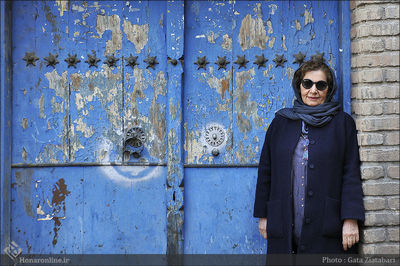Pariyoush Ganji (born in 1945, Tabriz) is a painter, scholar and fabric designer, who on November 3, 2015 received The Order of Rising Sun from the Japanese government for her research on the influence of Sassanid designs through the Silk Road on kimono and obi, the latter being a traditional Japanese sash.
She talked to Honaronline about her life and work at the Haft-Seen Table of this year’s New Iranian calendar Year, also known as Nowruz. The Haft-seen table is a hallmark of Nowruz and a historical symbol for Persian culture. Many families in Iran consider the Haft-seen spread a source of blessing upon the arrival of the New Year.
On how she became a painter, Ganji, a child prodigy artist, insists she was born a painter: Art has to come from within. True, there should be some passion for art, but there needs to be some conditions as well that you need to meet in order to express yourself through any medium of art. I turned professional when I was in school. Within a few short years, I began painting professionally after attending the vocational school. I also went to college to study art.
Ganji has done things many of us can only dream of, all before even going to college. After the vocational school she went to Britain to study art and painting in the Saint Marian College and Sir John Cass School of Art, Architecture and Design. She then studied contemporary aesthetics or fabric design something her mother used to do. She also went to France and Japan where she showcased her work in galleries, painted live in front of people, and more.

This is when she began adopting the Japanese style of monochrome painting or ink wash – after she won a scholarship to study painting and art in Tokyo at the age of 22. There, the large-scale introduction of ink paintings and techniques triggered her production of paintings based on brushstroke delivery and tonal gradations of ink. Not all her ink paintings were monochromatic, she still used red colors as well, but works recreating space and light solely with gradations of black and white nevertheless represented the quintessence of her art of ink painting during that period. One of her biggest paintings is titled Night, Day, Night. It depicts the story of mankind. She says it begins with darkness, lights up with life, and ends in darkness and tranquility.
On why she chooses nature as theme to work on, Ganji says: You cannot find someone who doesn’t like nature. Both water and river have special meanings to me. Perhaps, this has something to do with my childhood memories when I spent a lot of time in Fasham, watching the river flow. But at nights, the same river looked scary to me. I don’t know why I’m still scared of watching the river at nights.
She however goes on to explain that river played an influential role in her paintings and personal thoughts and aspirations: I also painted windows for a period of 12 years, in four different stages of my life. I began painting red windows, then purple and white ones. I also added or suggested music to my painting atmosphere because I used to listen to music when doing the windows collection. In the past two years, I have begun doing some ink wash as well, but more is yet to come.
On Nowruz holidays, she says: Nowruz is full of happy memories. As kids, we used to talk about Nowruz two months in advance. We were a big family in a big house, so we celebrated Nowruz in a big fashion. My father was a merchant of fabrics. He always brought home beautiful fabrics from work. My mother would also buy us new shoes. She made beautiful dresses for us to wear in Nowruz so we could make a new beginning. As a contemporary artist, I still find inspiration in Nowruz partly as a result of happy memories from childhood, all those appealing romantic and nostalgic snapshots of specific moments in New Year celebrations. Those were my sweetest memories.

